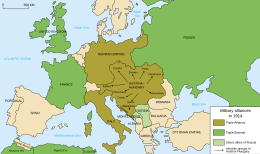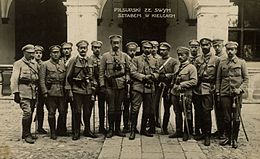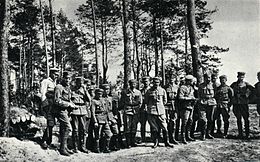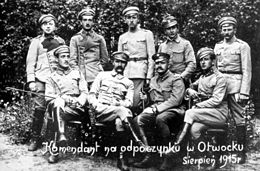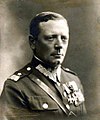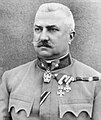|
Polish Legions in World War I
The Polish Legions (Polish: Legiony Polskie) was a name of the Polish military force (the first active Polish army in generations)[1] established in August 1914 in Galicia soon after World War I erupted between the opposing alliances of the Triple Entente on one side (comprising the British Empire, the French Republic and the Russian Empire) and the Central Powers on the other side, comprising the German Empire and Austria-Hungary.[2] The Legions became "a founding myth for the creation of modern Poland" in spite of their considerably short existence;[1] they were replaced by the Polish Auxiliary Corps (Polish: Polski Korpus Posiłkowy) formation on 20 September 1916, merged with Polish II Corps in Russia on 19 February 1918 for the Battle of Rarańcza against Austria-Hungary, and disbanded following the military defeat at the Battle of Kaniów in May 1918,[3] against Imperial Germany. General Haller escaped to France to form the Polish army in the West against the anti-Polish German-Bolshevik treaty.[4] The Legions took part in many battles against the forces of the Imperial Russia, both in Galicia and in the Carpathian Mountains. They suffered heavy casualties outnumbered three to one in the Battle of Łowczówek. They captured Kielce, and in 1915 took part in the offensive on Warsaw. In June 1916 the unit had approximately 25,000 soldiers.[1] Both the number of troops and the composition of units changed rapidly. After the Battle of Kostiuchnówka where 2,000 Polish soldiers died delaying a Russian offensive, Józef Piłsudski demanded that the Central Powers issue a guarantee of independence for Poland and partially succeeded.[5] The Polish Legions became the Polish Auxiliary Corps. After the Act of 5th November of 1916 which pronounced the creation of the puppet Kingdom of Poland of 1916–18, the Polish Legions were transferred under German command. However, most of the members refused to swear allegiance to the German Kaiser and were interned in Beniaminów and Szczypiorno (the Oath crisis). Approximately 3,000 of them were drafted into the Austro-Hungarian army and sent to the Italian Front while approximately 7,500 stayed in the Polish Auxiliary Corps, part of the failed German Polnische Wehrmacht.[citation needed] HistoryAccording to Prit Buttar, "When war broke out, Piłsudski was quick to recognize that an important preliminary step in Poland's path to independence was the defeat of tsarist Russia... Piłsudski was no supporter of the Central Powers, and once Russia had been driven out of Polish territory, he believed that he and his fellow Poles would have to persuade the Germans and Austro-Hungarians to leave too, but he held secret meetings with representatives of France and Great Britain to make clear to the western members of the Entente that Polish troops would never fight against them, only against Russia."[6] The formation of the Legions was declared by Józef Piłsudski in his order of August 22, 1914. The Austrian government, having jurisdiction over the area, officially agreed to the formation on August 27, 1914. The unit became an independent formation of the Austro-Hungarian Army thanks to the efforts of the KSSN and the Polish members of the Austrian parliament. Personnel came mostly from former members of various scouting organizations, including Drużyny Strzeleckie and Związek Strzelecki, as well from as volunteers from all around the Austro-Hungarian Empire. Initially, the Polish Legions were composed of two legions: the Eastern and the Western Legion, both formed on August 27. After a Russian victory in the Battle of Galicia (August–September 1914) the Eastern Polish legion refused to fight on behalf of the Austro-Hungarian side against Russia and was disbanded on September 21. On December 19, the Western legion was transformed into three brigades: the I Brigade of the Polish Legions under Józef Piłsudski, formed in mid-December; the II Brigade of the Polish Legions under Józef Haller de Hallenburg, formed between mid-December and March (sources vary); and the III Brigade of the Polish Legions under Zygmunt Zieliński (later Bolesław Roja), formed on May 8, 1915. All brigades had the following:
The commanders of the Legions were consecutively: Gen. Karol Trzaska-Durski (September 1914 – February 1916), Gen. Stanisław Puchalski (until November 1916), Col. Stanisław Szeptycki (until April 1917), and Col. Zygmunt Zieliński (until August 1917). After the war ended the officers of the Polish Legions became the backbone of the Polish Army.
BattlesBelow is a list of prominent Polish battles against the Imperial Russian Army in 1914–16, leading to victories in most cases, with notable exceptions especially during the Brusilov Offensive of 1916.
Notable officers who served in the Polish LegionsFollowing the foundation of the Second Polish Republic, many served in the Polish Army, and held political as well as elected offices. Polish Legions' prominent members
See alsoWikimedia Commons has media related to Polish Legions in World War I.
External links
Notes and references
|
||||||||||
